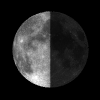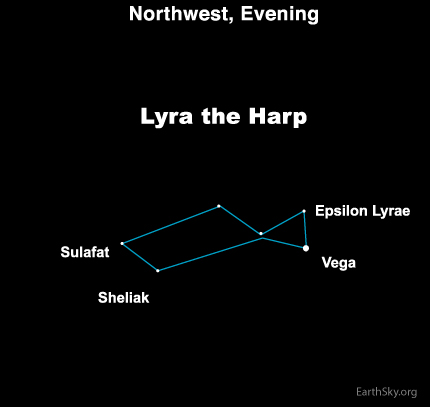Courtesy of EarthSky
A Clear Voice for Science
Visit EarthSky at
www.EarthSky.org [1]
 [2]
[2] [3]This evening, we zoom in on a variable star – a star whose brightness changes – near the star Vega [4] in the small but distinctive constellation Lyra the Harp.
[3]This evening, we zoom in on a variable star – a star whose brightness changes – near the star Vega [4] in the small but distinctive constellation Lyra the Harp.
Here is how to locate it. A dark sky brings out the four rather faint stars to the left of Vega. These stars form a parallelogram – a four-sided figure with its opposite sides equally long and parallel to one another. Three fingers at an arm length are enough to cover over this small parallelogram of stars.
The two stars shining on the left-hand side of the parallelogram are Sulafat and Sheliak. Sheliak is the variable star.
This star varies because – although Sheliak looks single to the eye – it is really a binary star, or two stars that revolve around one another. Sheliak is special kind of binary star system, known as an eclipsing binary. One star in the Sheliak system blocks out the light of its companion star in regular periods, as seen from our earthly vantage point. This blocking of one star by the other causes Sheliak’s brightness to dim every 6.5 days.
Normally, Sheliak and Sulafat are equal in brightness. However, when one of Sheliak’s stars eclipses the other, Sheliak is the fainter star. Find brilliant Vega first, then Sheliak and Sulafat. See if Sheliak looks fainter than Sulafat.
By the way, in our western sky lore, the constellation that contains all these stars – Lyra – represents a Harp. In Greek mythology, Lyra was associated with the myth of Orpheus, the musician whose music was so sweet that the king of the gods, Zeus, placed both Orpheus and his harp in the night sky. Lyra was also known as King Arthur’s Harp (Talyn Arthur), and King David’s harp. It was known to the Romans as Tympanum (drum), and Canticum (song).
In our modern times, Sheliak keeps a beat of its own – not a musical beat, but a visual one – as this star’s brightness waxes and wanes in a way that’s regular and observable.
![]() [5]Written by Deborah Byrd [6]
[5]Written by Deborah Byrd [6]
Astronomy Picture of the Day from NASA/JPL [7]
U.S. Naval Observator Astronomical Information cente [9]r
Universe Today [10]
StarDate Online [11]
Sky and Telescope [12]
National Geographic [13]
Space Com [14]
Simostronomy Blog [15]
Amazing Space [16]
The York County Astronomical Society [17]
Scope City [18]